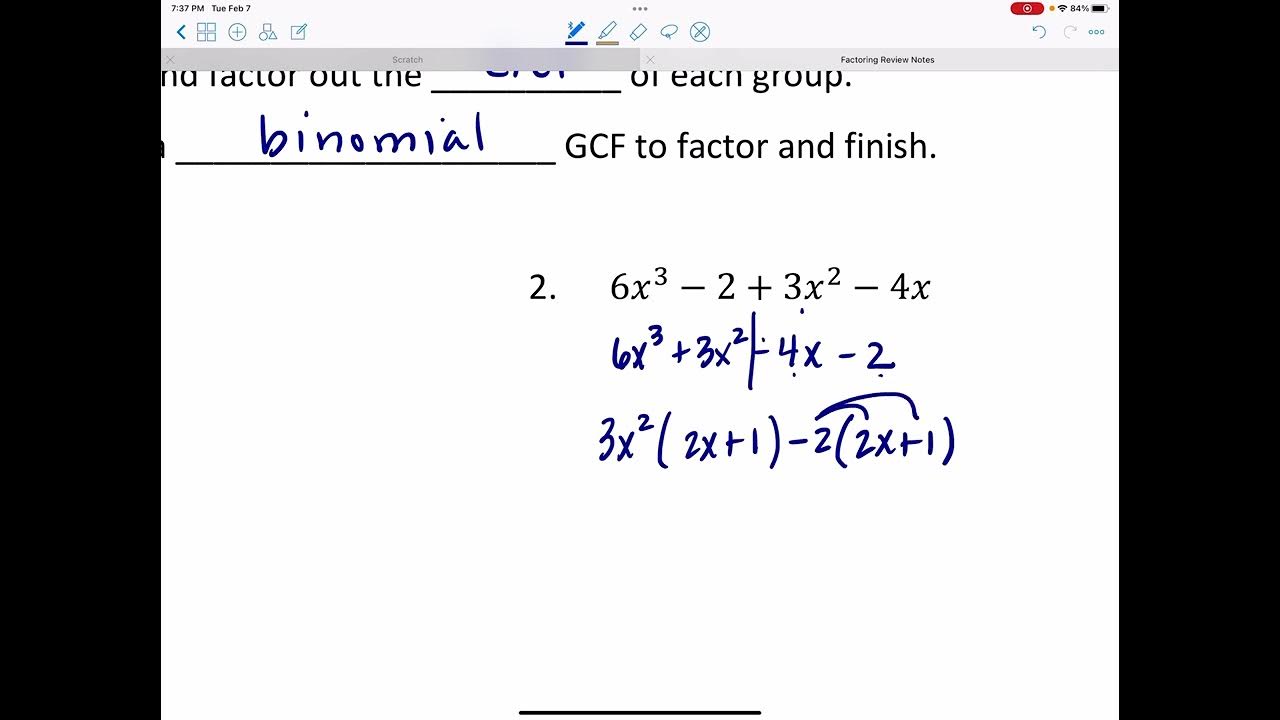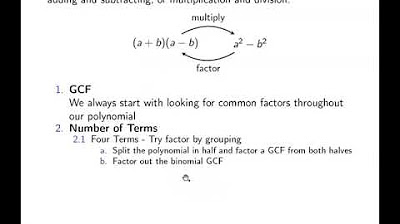Follow this tip when factoring by grouping
TLDRIn this educational video, the presenter highlights a common mistake students make when factoring by grouping: incorrectly grouping terms and creating multiplication problems instead. The key tip is to change subtraction to addition to avoid this error. The video demonstrates how to correctly group terms, factor out the greatest common factor (GCF), and check work for accuracy. It concludes with applying the difference of two cubes formula for complete factorization, ensuring students can avoid the typical pitfalls in algebraic factoring.
Takeaways
- 📚 Factoring by grouping is a common method for polynomials with four terms.
- 🔍 Arrange terms in descending order to prepare for factoring by grouping.
- ❌ Avoid incorrect grouping by not creating a multiplication problem with parentheses.
- 🔄 Change subtraction to addition to simplify the process of factoring by grouping.
- 📝 Remember that 5 - 4 is the same as 5 + (-4), which helps in rearranging terms.
- 👉 Group the first two terms and the last two terms, ensuring operations are not altered.
- 📉 Factor out the greatest common factor (GCF) to simplify expressions.
- 🔍 After factoring out the GCF, check that the remaining expressions are the same to ensure correct factoring.
- 📌 Look for the difference of cubes pattern if you have a cubic term minus another cubic term.
- 📘 Apply the formula for the difference of cubes (a^3 - b^3 = (a - b)(a^2 + ab + b^2)) to further factor the expression.
- 🎯 After fully factoring, verify your work by multiplying the factors back to the original expression.
Q & A
What is the main topic of the video?
-The main topic of the video is to demonstrate a common mistake students make when factoring by grouping and to provide a tip to avoid this mistake.
What is the first step when factoring by grouping?
-The first step is to group the first two terms and the last two terms of a polynomial with four terms.
Why is it important to arrange terms in descending order when factoring by grouping?
-Arranging terms in descending order helps to ensure that the terms are grouped correctly and that the operations are not changed during the factoring process.
What is the common mistake students make when adding parentheses during factoring by grouping?
-The common mistake is creating a multiplication problem by adding parentheses, which changes the operations and leads to an incorrect factoring.
What is the rule suggested in the video to avoid the mistake of changing operations during factoring by grouping?
-The rule is to change a subtraction problem to an addition problem by adding a negative to the terms, which allows for correct grouping without changing the operations.
How does changing from a subtraction to an addition help in factoring by grouping?
-Changing to an addition allows for the terms to be grouped without altering the operations, making it possible to factor by grouping correctly.
What is the purpose of factoring out the greatest common factor (GCF)?
-Factoring out the GCF simplifies the expression and makes it easier to identify common terms that can be factored out further.
How can you check if your factoring by grouping is correct?
-You can check by multiplying the factored terms back to see if they match the original expression.
What is the difference of two cubes formula mentioned in the video?
-The difference of two cubes formula is a^3 - b^3 = (a - b)(a^2 + ab + b^2).
Why is it important to ensure that the expressions left after factoring out the GCF are the same?
-Ensuring the expressions are the same confirms that the factoring is correct and allows for further factoring, such as applying the difference of two cubes formula.
What is the final step in the video after factoring out the common terms?
-The final step is to apply the difference of two cubes formula if applicable, to completely factor the polynomial.
Outlines
📚 Mastering Factoring by Grouping: Common Mistakes and Tips
This paragraph discusses a common mistake students make when factoring by grouping, which involves polynomials with four terms. The instructor emphasizes the importance of arranging terms in descending order and cautions against incorrect grouping that leads to multiplication problems. The key tip is to change subtraction to addition when there's a negative sign between terms, allowing for proper grouping without altering the equation's meaning. The summary also includes a step-by-step demonstration of factoring out common terms like x cubed and checking work by ensuring the remaining expressions are identical after factoring out the greatest common factor (GCF).
🧩 Applying the Difference of Cubes Formula for Complete Factorization
The second paragraph focuses on the application of the difference of cubes formula to fully factor a polynomial. It explains the recognition of cube numbers within the expression and the use of the formula a^3 - b^3 = (a - b)(a^2 + ab + b^2) to rewrite the expression in factored form. The instructor guides through identifying 'a' and 'b' as the cube roots of the respective terms, demonstrates the factorization process, and encourages viewers to watch the next video for further understanding of factoring by grouping techniques.
Mindmap
Keywords
💡Factoring by Grouping
💡Polynomial
💡Greatest Common Factor (GCF)
💡Descendant Order
💡Common Mistake
💡Multiplication Problem
💡Addition Problem
💡Difference of Two Cubes
💡Cube Root
💡Checking Work
💡Factored Form
Highlights
The video aims to show a top mistake students make when factoring by grouping and provides a tip to avoid it.
Students are advised to consider factoring by grouping when they see a polynomial with four terms.
The importance of arranging terms in descending order for factoring by grouping is emphasized.
A common mistake is incorrectly grouping terms by adding parentheses, which changes the multiplication problem.
Another mistake is changing the sign incorrectly when grouping terms around a negative sign.
The correct method is to change a subtraction problem to an addition problem to facilitate proper grouping.
The video explains how to group terms correctly by changing the operation between terms.
Factoring by grouping is demonstrated with an example, including factoring out the greatest common factor (GCF).
A tip for checking work after factoring out the GCF is provided.
The necessity of ensuring that the expressions left after factoring out are the same is discussed.
The video demonstrates how to correct mistakes in the factoring process and verify the results.
The difference of two cubes formula is introduced as a method to further factor the expression.
The process of identifying 'a' and 'b' in the difference of two cubes formula is explained.
The final step of completely factoring the polynomial using the difference of two cubes is shown.
The video concludes with a summary of how to avoid common mistakes in factoring by grouping.
An invitation to watch the next video for more information on factoring by grouping is extended.
Transcripts
Browse More Related Video

Learn the ac method for factoring and solving a quadratic equation

Factoring Trinomials & Polynomials, Basic Introduction - Algebra

Factoring Review

Factoring Polynomials - By GCF, AC Method, Grouping, Substitution, Sum & Difference of Cubes

How To Factor Polynomials The Easy Way!

Ch. 1.3 Algebraic Expressions
5.0 / 5 (0 votes)
Thanks for rating: